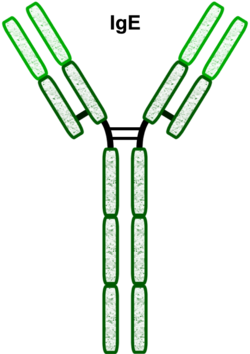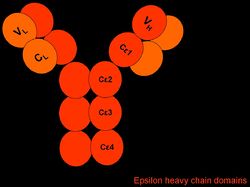Difference between revisions of "Immunoglobulin E"
(Created page with '{{review}} <p>''Shortened to IgE''</p> thumb|150px|right|'''IgE''' thumb|right|150px|IgE - B. Catchpole, RVC 2008 <p>Unlike IgM, IgG and [[…') |
|||
| (23 intermediate revisions by 5 users not shown) | |||
| Line 1: | Line 1: | ||
| − | {{ | + | {{OpenPagesTop}} |
| − | + | ==Overview== | |
| − | [[Image:LH IgE.png|thumb| | + | [[Image:LH IgE.png|thumb|250px|right|'''IgE''']] |
| − | [[Image:IgE.jpg|thumb|right| | + | [[Image:IgE.jpg|thumb|right|250px|IgE - B. Catchpole, RVC 2008]] |
| − | + | ||
| + | Commonly referred to as ''IgE''. | ||
| + | |||
| + | Unlike [[IgM]], [[IgG]] and [[IgA]], IgE does not function as a soluble antibody, with binding to Fcε receptors required before it can bind to the target antigen, and is found in low levels in blood plasma. Like [[IgA]], it is produced by [[B cell differentiation|plasma cells]] and is mainly localised to mucosal surfaces. | ||
| + | |||
==Structure== | ==Structure== | ||
| − | + | ||
| − | ''Note: Janeway <ref>{{citation|initiallast = Janeway|initialfirst = C.A|2last = Travers|2first = P|3last = Walport|3first = M|finallast = Shlomchik|finalfirst = M.J|year = 2005|title = Immunobiology: The immune system in health and disease|ed = 6th |city = New York|pub = Garland Science Publishing|range = 156-157}}</ref> states that IgE has no hinge region whereas Tizard <ref>{{citation|initiallast = Tizard|initialfirst = I.R|year = 2004|title = Veterinary Immunology: An Introduction|ed = 7th|city = Philadelphia|pub = Saunders|range = 148-149}}</ref> indicates that it does. | + | IgE is Y-shaped with heavy chain type ε, and exists as a monomer. |
| + | |||
| + | ''Note: Janeway <ref>{{citation|initiallast = Janeway|initialfirst = C.A|2last = Travers|2first = P|3last = Walport|3first = M|finallast = Shlomchik|finalfirst = M.J|year = 2005|title = Immunobiology: The immune system in health and disease|ed = 6th |city = New York|pub = Garland Science Publishing|range = 156-157}}</ref> states that IgE has no hinge region whereas Tizard <ref>{{citation|initiallast = Tizard|initialfirst = I.R|year = 2004|title = Veterinary Immunology: An Introduction|ed = 7th|city = Philadelphia|pub = Saunders|range = 148-149}}</ref> indicates that it does.'' | ||
| + | |||
==Production== | ==Production== | ||
| − | + | ||
| + | It is produced when T<sub>H</sub>2 cells stimulate CD40 and produce IL-4 and IL-13, which causes B cell differentiation to plasma cells and class switching to IgE production. | ||
| + | |||
==Function== | ==Function== | ||
| − | + | ||
| − | + | IgE triggers acute inflammation by binding to the FCεRI receptors on mast cells in the lamina propria and [[Basophils|basophils]], causing degranulation when bound to target. It is involved in [[Type I Hypersensitivity|type I hypersensitivity reactions]]. Cross-linking of IgE molecules by antigens, triggers [[Mast Cells|mast cell]] and [[Eosinophil|eosinophil]] degranulation and an inflammatory response. IgE has considerable involvement in producing [[Immunity to Parasites|immunity to parasitic worms]], particularly [[:Category:Nematodes|nematode]] parasites. It may mediate their expulsion or killing via mast cell activity, cytotoxic [[Eosinophils|eosinophils]], [[Macrophages|macrophages]], and so on. | |
| − | + | ||
| − | |||
| − | |||
| − | |||
| − | |||
==References== | ==References== | ||
<references /> | <references /> | ||
<br> | <br> | ||
| − | + | ||
| − | + | ==Links== | |
| + | |||
| + | [[Immunoglobulins|Immunoglobulins]] | ||
| + | |||
| + | [[Immunoglobulin A|Immunoglobulin A]] | ||
| + | |||
| + | [[Immunoglobulin D|Immunoglobulin D]] | ||
| + | |||
| + | [[Immunoglobulin G|Immunoglobulin G]] | ||
| + | |||
| + | [[Immunoglobulin M|Immunoglobulin M]] | ||
| + | <br><br> | ||
| + | {{Jim Bee 2007}} | ||
| + | |||
| + | {{OpenPages}} | ||
| + | [[Category:Immunoglobulins]] | ||
| + | [[Category:A&P Done]] | ||
Latest revision as of 16:08, 2 July 2012
Overview
Commonly referred to as IgE.
Unlike IgM, IgG and IgA, IgE does not function as a soluble antibody, with binding to Fcε receptors required before it can bind to the target antigen, and is found in low levels in blood plasma. Like IgA, it is produced by plasma cells and is mainly localised to mucosal surfaces.
Structure
IgE is Y-shaped with heavy chain type ε, and exists as a monomer.
Note: Janeway [1] states that IgE has no hinge region whereas Tizard [2] indicates that it does.
Production
It is produced when TH2 cells stimulate CD40 and produce IL-4 and IL-13, which causes B cell differentiation to plasma cells and class switching to IgE production.
Function
IgE triggers acute inflammation by binding to the FCεRI receptors on mast cells in the lamina propria and basophils, causing degranulation when bound to target. It is involved in type I hypersensitivity reactions. Cross-linking of IgE molecules by antigens, triggers mast cell and eosinophil degranulation and an inflammatory response. IgE has considerable involvement in producing immunity to parasitic worms, particularly nematode parasites. It may mediate their expulsion or killing via mast cell activity, cytotoxic eosinophils, macrophages, and so on.
References
Links
| Originally funded by the RVC Jim Bee Award 2007 |
Error in widget FBRecommend: unable to write file /var/www/wikivet.net/extensions/Widgets/compiled_templates/wrt663135b3d0f0c1_56530419 Error in widget google+: unable to write file /var/www/wikivet.net/extensions/Widgets/compiled_templates/wrt663135b3d42d36_57378403 Error in widget TwitterTweet: unable to write file /var/www/wikivet.net/extensions/Widgets/compiled_templates/wrt663135b3d74d70_90137605
|
| WikiVet® Introduction - Help WikiVet - Report a Problem |

